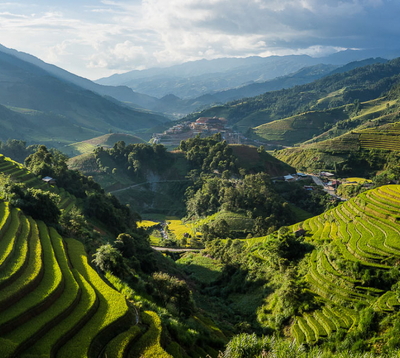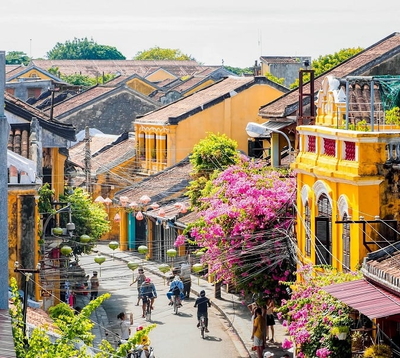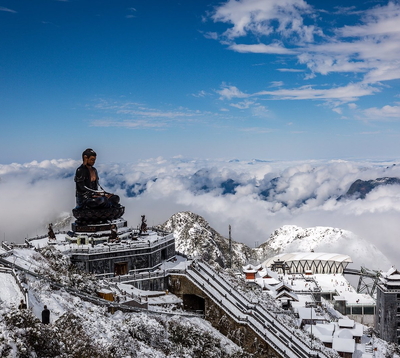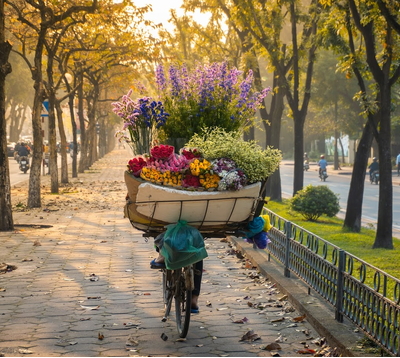Travel Guide to Điện Biên Phủ Vietnam - Perfect Off-the-beaten-track in North Vietnam
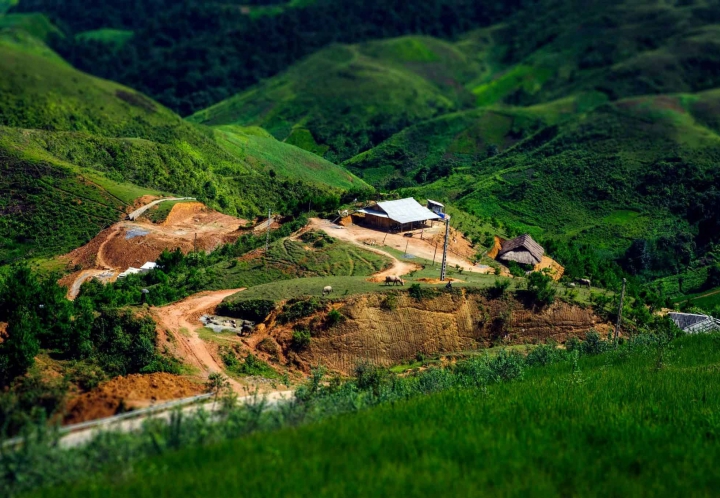
When you hear Dien Bien Phu, the first thing you think of obviously the battle of century – Battle of Dien Bien Phu between French Union’s French Far East Expeditionary Corps and Viet Minh communist-nationalist revolutionaries. The thing you might not know is Dien Bien Phu is a beautiful, pristine and perfect off-the-beaten-track destination in Northwest Vietnam with incredible natural and enriched cultural beauties. In this travel guide, we’ll show all the things you need to know before traveling to Điện Biên Phủ Vietnam.
| >>> Related Post: 15+ Top Things to do in Sapa - Update 2020 |
Battle of Điện Biên Phủ
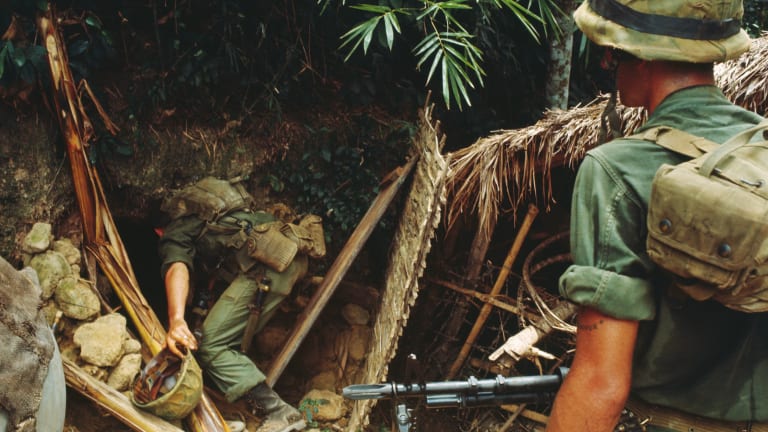
The battle occurred between March and May 1954, resulted in a comprehensive French defeat, and great influenced on the negotiations underway at Geneva among several nations over the future of Indochina.
As of today, Dien Bien Phu is stilled referred by Vietnamese people as the greatest victory in modern history which had made General Vo Nguyen Giap – the battle commander – one of the greatest military commanders in the 20th century.
Starting from late 1953, French forces began to occupy Dien Bien Phu valley in order to turn it into a stronghold and draw the enemy into a decisive battle. Viet Minh commander Vo Nguyen Giap amassed troops and placed heavy artillery in caves of mountains overlooking French camp without the French knowing. From in March 1954, Giap started assaults on opposition’s strong point, eliminating the use of French airfield, sending the French into an unescapable hell on earth. Giap’s first intention was a fast offensive aiming for a fast victory. But in his reevaluation of the situation, he changed the offensive into a siege employing the ‘trench warfare’ tactic which ultimately took 57 days to achieve the final victory.
On May 7, resistance from French forces ceased, Dien Bien Phu was taken back by Viet Minh revolutionists. This defeated essentially ended the French presence in Indochina. Until this day, Dien Bien Phu victory still holds so much value as the most military event that united Vietnamese people and proved that the weak still can win against the strong if there are enough determination and will.
Dien Bien Phu Today
Nowadays, Dien Bien Phu is changing and developing rapidly but still remains a quiet mountainous city of northwest Vietnam. Located in the farthest region of northwest Vietnam, Dien Bien Phu in particular and Dien Bien province see a high proportion of ethnic minorities who are proud to celebrate their own authentic culture.
Things to in Điện Biên Phủ Vietnam
Museum of Dien Bien Phu Victory
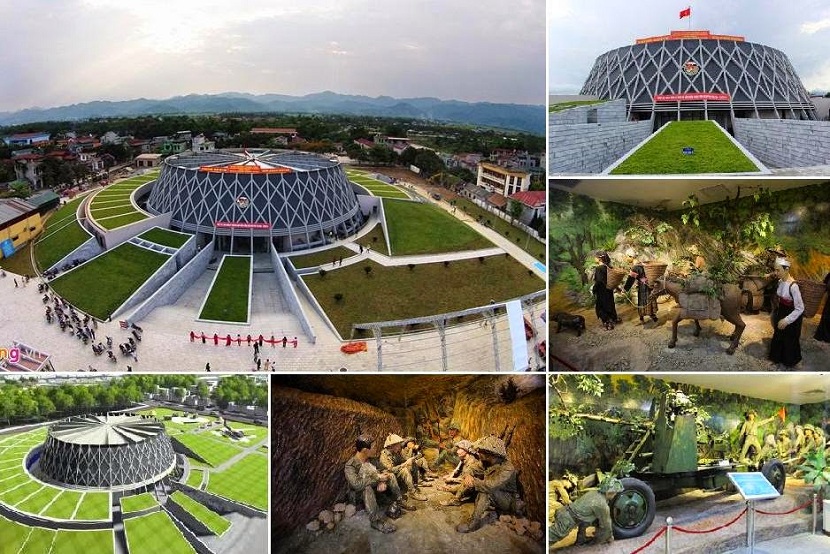
Before heading to Dien Bien Phu battle relics, it’s wise to understand the context of this historic battle. And nowhere does that job better than the Museum of Dien Bien Phu Victory. Put aside the propaganda you might or might not see here, the museum is the place that keeps most important documents and images related to the battle.

Opened in May 2014 on the 60th anniversary of Dien Bien Phu Victory, the museum’s outside design resembles the camouflage netting on the helmet of Vietnamese soldiers. These four themes of exhibition: Vietnamese resistance, the battle itself, international support and the consequence of this victory. These four themes are well displayed via the five sections, 270 objects and more than 200 paintings, photos of great historical value.
Come to the museum to understand more about Dien Bien Phu Battle and ultimately the Vietnamese people in wartime.
Dien Bien Phu Battle Relics
Him Lam Hill
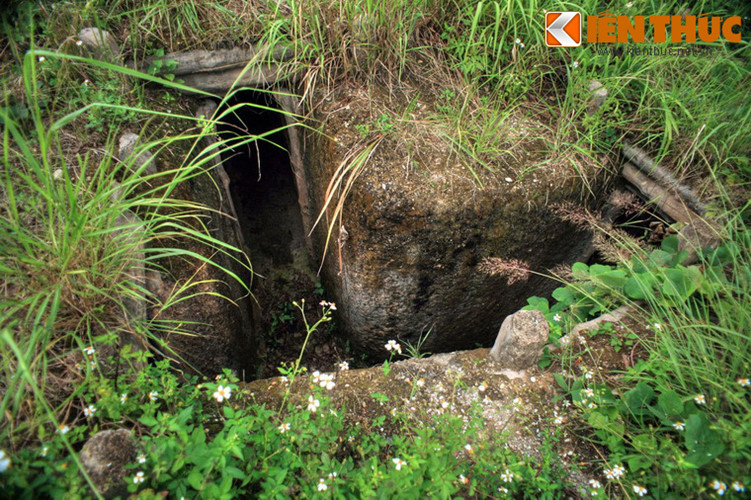 Photo: Kien Thuc
Photo: Kien ThucOr Beatrice as the French called, witnessed the first battle of the whole Dien Bien Phu Offensive on March 13 1954. Him Lam hill was seemingly the entrance of the Dien Bien Phu strongpoint, located 2 kilometers away from center sector, also served as the watch point of French artillery and air force in Muong Thanh. This hill was considered of great important to the French because of its function as a distant protecting point.
On the first day of the offensive Vietminh poured down bombardment into the valley – a move French had not predicted because, tragically, French underestimated the skill of Vietminh and especially of Vo Nguyen Giap. On this day, Vietminh bombshells killed two French commanders. And two days later, French artillery commander, Colonel Charles Piroth, distraught at his inability to bring counterfire on well-camouflaged Vietminh batteries, committed suicide with a hand grenade inside his dugout.
The victory of Him Lam Hill ‘galvanized’ the morale of Vietminh troops.
A1 Hill
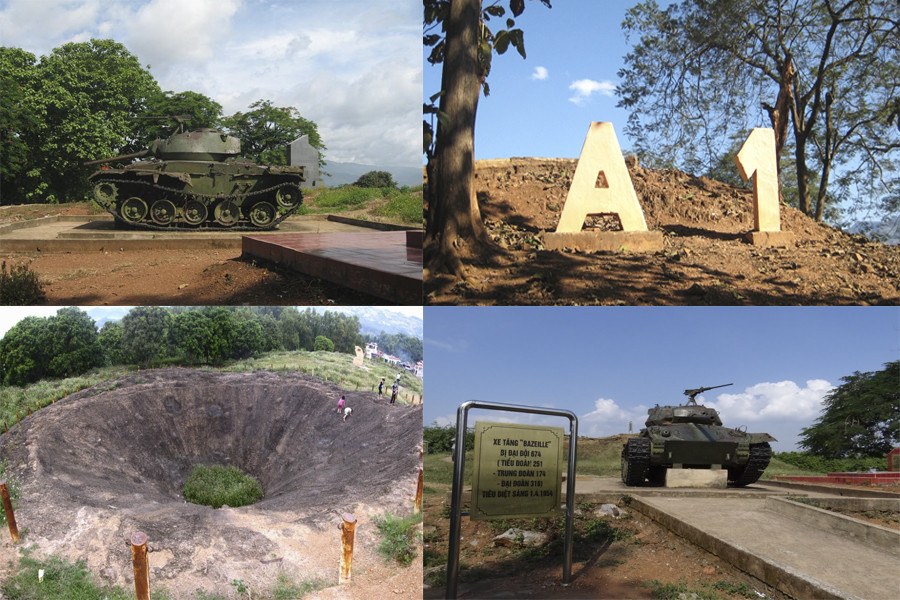
Or Colline Éliane or Eliane 2 as the French called, is the point the final battle happened, ended in the ultimate victory for the Vietminh. The fight at A1 Hill was the most desperate and ferocious battle of Dien Bien Phu Offensive. French placed bunkers every 10 meters which Vietminh could only pave way to eliminate after destroying enemy’s two tanks. The resistance from French side was strong and only until the explosion of the tunnels made by Vietminh on May 6, it fell apart. The bomb’s carter, tanks and tunnels are still visible until this day.
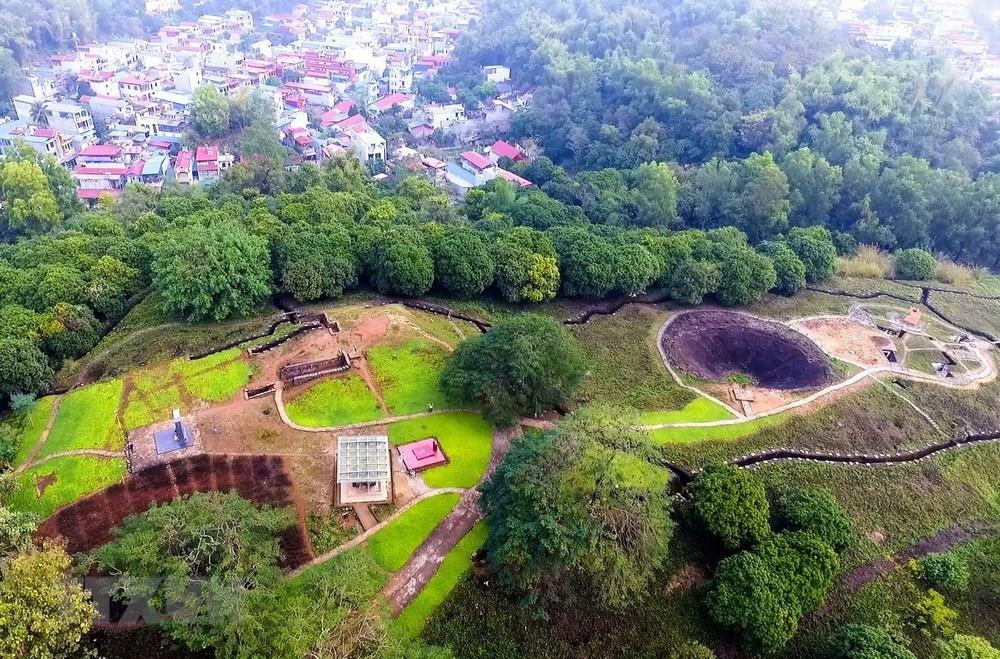
Reason for taking control of A1 became so vital due to the fact that this hill shielded the commander bunker of French’s General de Castries, overlooking other hills like D1, C2, C3, E1 and E2, Muong Thanh airport, A1 field and A1 cemetery. To Vo Nguyen Giap, this hill was indeed the hardest point to take with 39 days and nights spent and 2000 soldiers lost on this single hill. A Vietnamese veteran reminisced on A1 Hill’s fight: “It was hard to win every meter of land on A1 hill”.
Bunker of General of De Castries

Located in the center of Dien Bien Phu Garrison, French commander’s bunker is 20m in length and 8m in width, including rooms for both boarding and working. Standing on any hill of the strong-point, you can see this iconic bunker, the seize of which has been recorded and showed on TV by Vietnamese government every anniversary of Dien Bien Phu victory.
In the past, French used logs and sand bags to build a trench connecting the bunker and a blockhouse on Eliane 2 Hill. This trench was destroyed and is no longer exist. Also in this bunker, De Castries was captured on May 7 1954. This bunker is the must-see site in Dien Bien Phu.
Muong Thanh Rice Field – Largest Rice Field in Northwest Vietnam
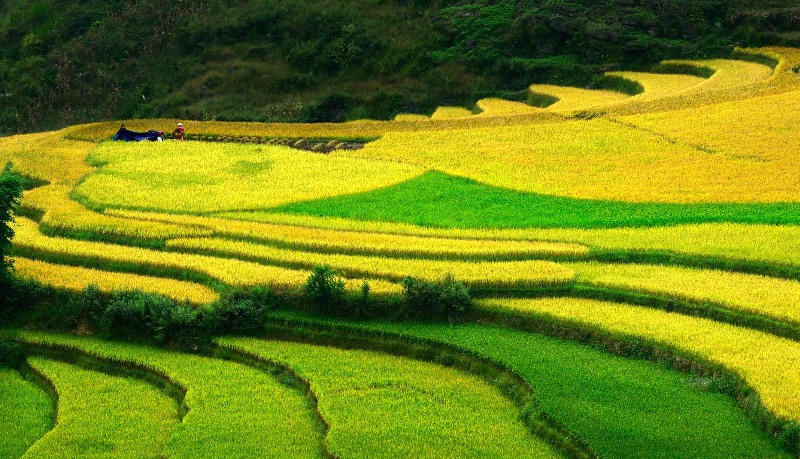
The largest field in northwest Vietnam, Muong Thanh field is located just few kilometers away from the city centre, spreading on 20 kilometers in length and 6 kilometers in width. It’s an ocean of rice field before your eyes.
When visiting in harvest season, starting from September, you’ll have chance to see a wonderful sight of local farmers laboring on the field, smiling contentedly with the bummer. It’s the sight that is often seen in North Vietnam for generations.

Muong Thanh field is nurtured by Nam Ron river, winding its way through the green rice fields, making a beautiful painting of Dien Bien countryside.
Don’t forget to visit an ethnic village here to have chance to taste the sweetness of rice on a familiar family meal.
Ride on Pha Din Pass
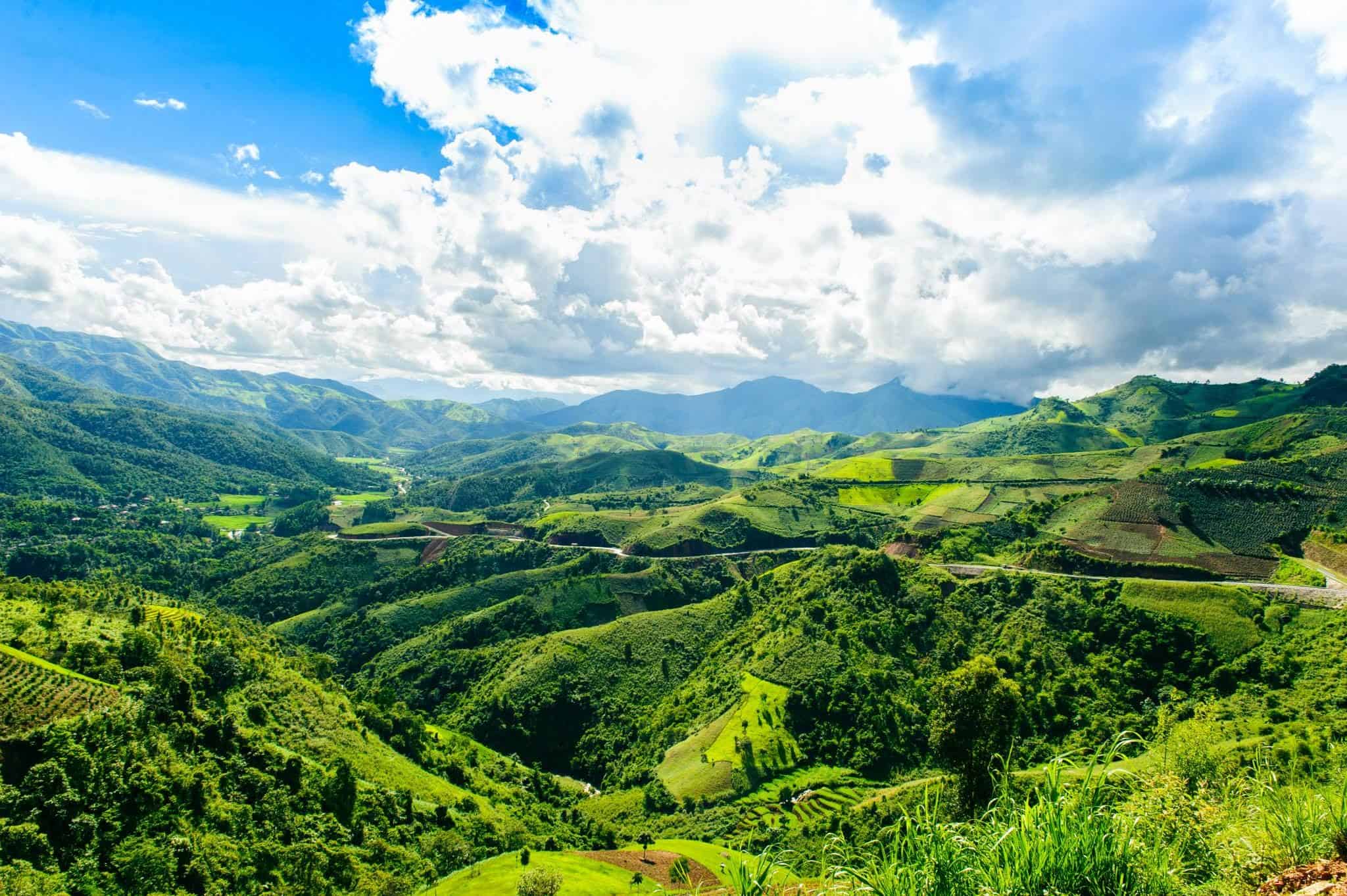
With a length of 32 kilometers, the famous Pha Din Pass connects two provinces – Son La and Dien Bien, located on National Highway 6. A part of the pass belongs to Phong Lai commune, Thuan Chau district, Son La and the other part belongs to Toa Tinh commune, Tuan Giap district, Dien Bien province.
The name of the pass ‘Pha Din’ originated from langue of local Thai people, in which ‘Pha’ means ‘sky’ and ‘Din’ means ‘earth’. The pass is where sky and earth meet.

Indeed the pass lived up to its name. In early mornings, the pass can be engulfed totally in white clouds or fog. Praised as one of the great four passes in Northern Vietnam besides the famous O Quy Ho, Khau Pha and Ma Pi Leng, Pha Din boasts so gentle a beauty which doesn’t take your breath away like that of Ma Pi Leng but rather ease your eyes with green mountains and azure river. The sight of rustic ethnic villages lying on the valley, nested behind the hills only evokes in you the urge of travel to lands you know nothing about.
Muong Lay – Valley of Stilt Houses
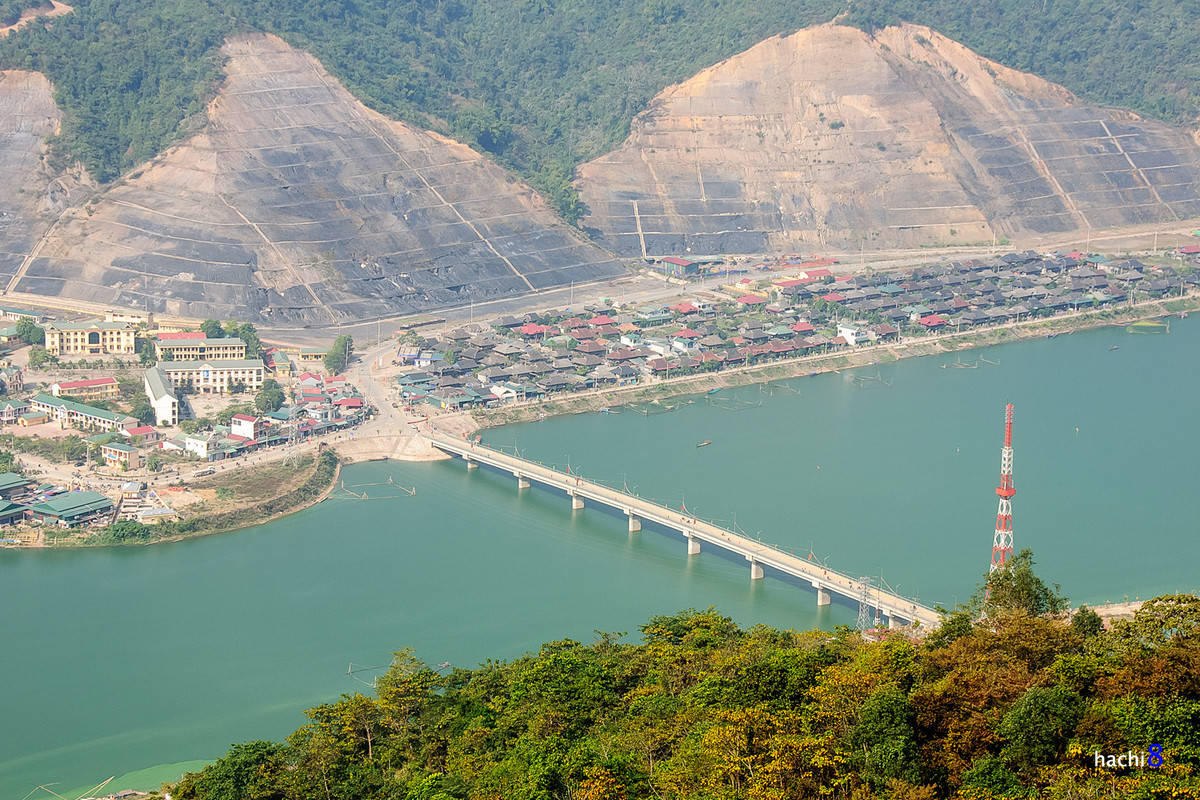
Muong Lay is some kind of legendary destination to local travelers, who wish to set foot on the most remote soils of the country. Through the years, Muong Lay has changed quite a lot and its beauty is only accreted.
Suffered from two floods of the notorious Da River in the past, Muong Lay was reborn with the inauguration of Son La Hydropower Plant. The town is on its way to become provincial city of Dien Bien which promises even prosperity and development in the days to come.
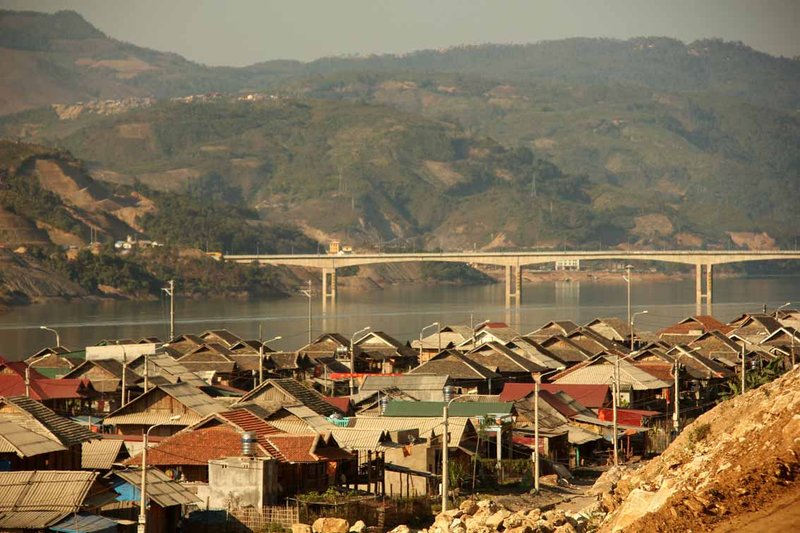
The sight of calm, azure water of Son La Reservoir means so much to the people here who had witnessed such ferocious and deadly floods of the river. A white concrete bridge connects the two sides of the lake, both belongs to 9 ethnic minorities living under the black roofed stilt houses located along the riversides. The most prominent indigenous culture in Muong Lay is White Thai people with its iconic traditional costume and authentic tradition that has become one of the most well-known attractions Northwest Vietnam.
Come to Muong Lay, it’s a pity if you miss a boat trip on Da River or visit to an ethnic handicraft village or homestaying in a Thai traditional stilt house. Muong Lay is the worthiest destination in Dien Bien, a gem in north Vietnam that is still untouched by tourism.
Relaxing boat ride at Pa Khoang Lake
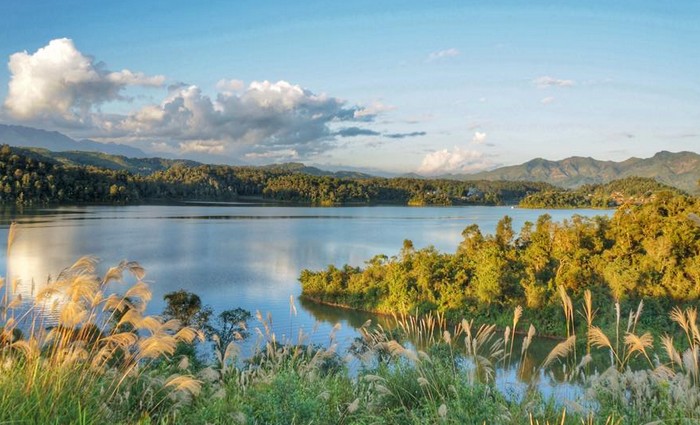
The man-made Pa Khoang Lake is located at Muong Phang district and only 20 kilometers away from Dien Bien Phu city. The lake is a famous natural site for tourists to relax and enjoy the nature beauties. With its total area of 2400 hectares, a rich flora and fauna, Pa Khoang offers a unique and pristine getaway from the dust of city. During summer or autumn, the lake surface is just like a gigantic mirror, reflecting the blue sky, the grey mountains. To enjoy the calm and gentle waves, go on a boat trip just when sunset is about to fall. The boat will take you to the islet lying at the middle of Pa Khoang lake which given the name ‘Love Islet’ or Cherry Blossom Islet by the local people. On the islet lies a large garden of Japanese cherry blossom which covers the whole island with its dreamy pastel pink color.
At Pa Khoang, you can also try your hands at fishing, while let your eyes enjoy the beauties of nature.
Visit Cherry Blossom Garden in Muong Phang
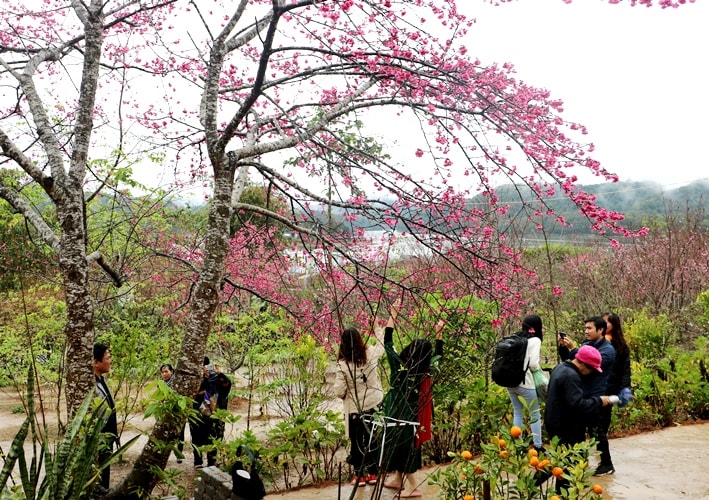
Muong Phuong was well known as where Dien Bien Phu Offensive’s command headquarter was located. But Cherry Blososm Garden of Muong Phuong, lies on an islet of Pa Khoang Lake is still a hidden gem of Dien Bien Phu.
The garden is a result of the friendship between two countries: Vietnam and Japan. The garden owner was friend with a Japanese who gave him 10 seeds of cherry blossom plants. The owner brought the seeds to Muong Phang and now he has grown 40 cherry blossom trees that bloom every spring.

The boat will take about 10 minutes to get to the islet. The best time to visit this island is from February to April. Note that the cherry blossoms in Muong Phuong bloom 2 months sooner than those in Japan.
Discover Xa Nhe Cave, short visit to Xa Nha Fair Market
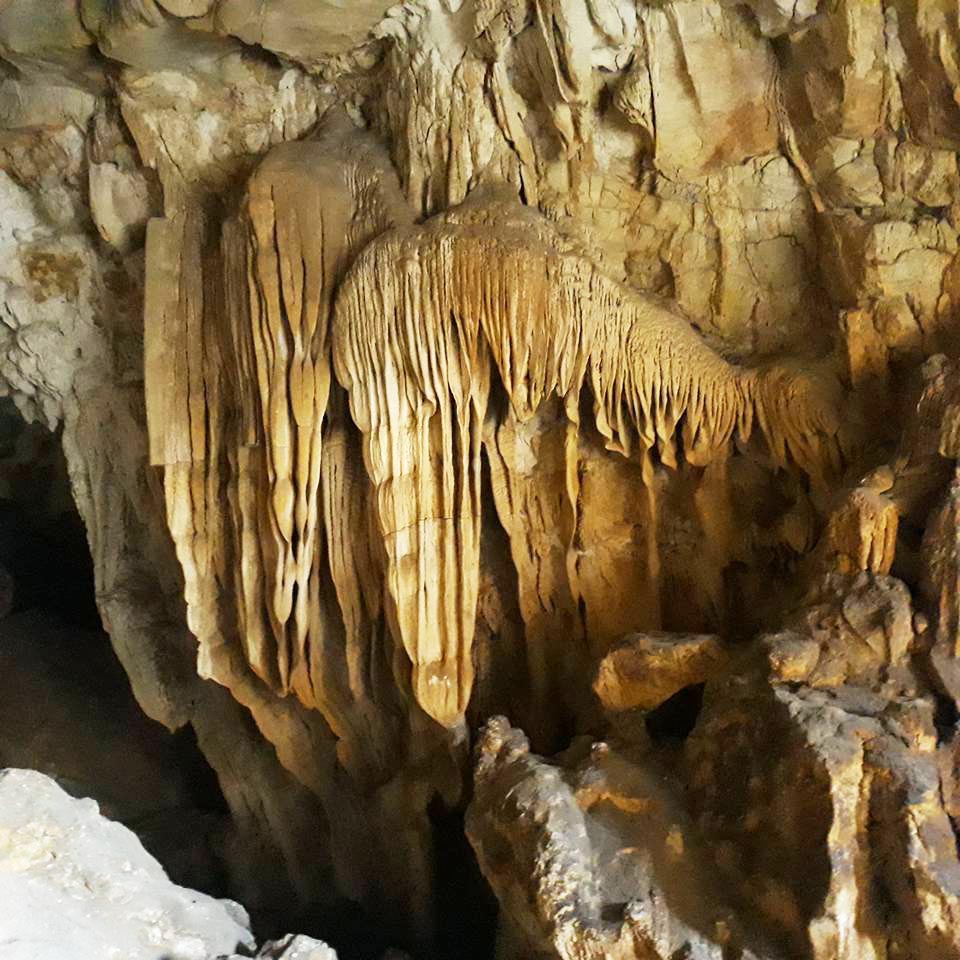
Xa Nhe Cave is located at Xa Nhe commune, south of Tua Chua district. The cave is named ‘Kho Xo’ in H’mong language, meaning ‘Dynamite Cave’, originated from the fact that bats used to live inside the cave, the locals came to collect their dung to make dynamite.
Xa Nhe cave is located under a sheer cliff of mountain, about 1 kilometer away from the central town of Sang Nhe commune. The cave and its surrounding is still primitive and untouched by tourism. But once you get inside, you’ll be surprise by the imposing beauty of colossal columns of stalagmite. The cave is 700m long with 5 chambers of different sizes and different beauties.

Once you’re in Xa Nhe, why not visit Xa Nhe fair market, opens only once in every 6 days. The market is gathered at the central town of Xa Nhe commune with the participation of several ethnic minority groups such as H’mong, Thai, Zao and Phu La…. Each of this group can be distinguished by their own distinctive traditional costume.
People from all surrounding areas also come to the market to trade goods, foodstuff and clothes. The market starts from daybreak to afternoon. Visit Xa Nhe market to enjoy local food, festive atmosphere and authentic cultural practice.
Soak up the local culture at Ta Sin Thang fair market

Ta Sin Thang is not only a fair market but also a place for culture exchange and chance to find romance. Opening only once every 6 days, Ta Sin Thang market is a mini festival of the highland welcoming H’mong and other ethnic people from surrounding region to come with their best clothes to trade goods, sharing stories, eat and even date. The busiest hour of the market is around noon, when the people start to gather around tables for lunch. It’s when Dien Bien staple alcohol drink – Mong Pe wine is going to be served.
Ta Sin Thang fair market is also the place you can find authentic brocade products made by the hands of H’mong women.
What to eat in Dien Bien Phu
Dien Bien Sticky Rice
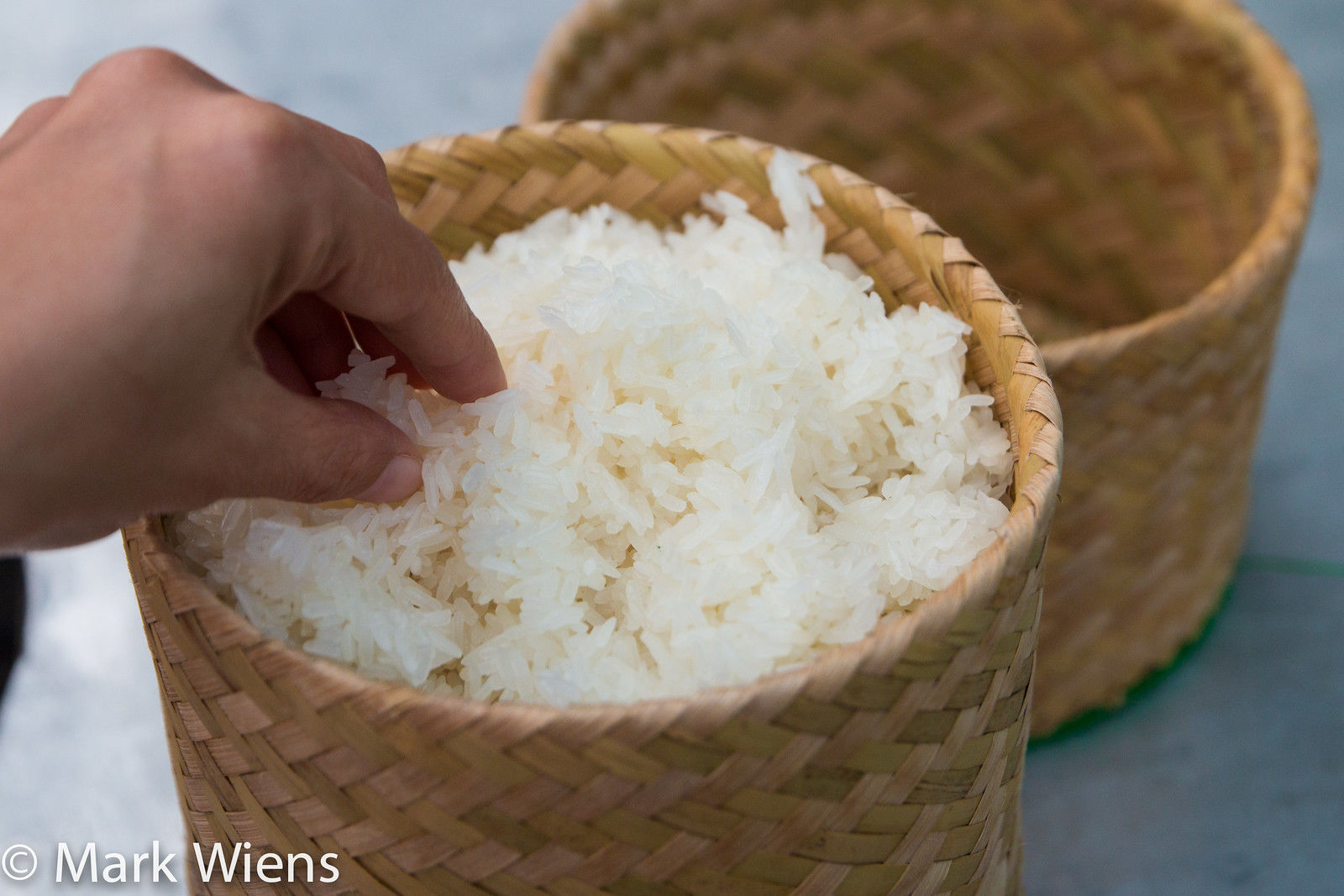 Photo: Mark Wiens
Photo: Mark Wiens
Besides the historical victory, Dien Bien has been known ages ago for its special rice. Dien Bien glutinous rice cooked as sticky rice with its fragrance, light sweet taste is one of the must-try dishes when you visit Dien Bien Phu. The sticky rice exceptional better when eaten in chilly days of mountainous areas.
Black chicken Tua Chua

Black chicken is a specie of chicken only found in H’mong residence, with H’mong name ‘Ka Du’. Ka Du chickens are precious to H’mong people, always listed as a high value gift or procession. The black chickens in Tua Chua are known its delicious black meat, black bone, even black organs. People eat Ka Du chicken for its nutrients and health benefits.
Bitter bamboo shoots
This specialty can be found in many other places in northwest Vietnam. The bamboo shoots can be cooked into many different dishes, boiled, stir-fried or stew. A bowl of soup containing bitter bamboo shoots will be fantastic and fill you up real quick in cold days.
Khau Xen in Muong Lay

Khau Xen is a traditional snack of Thai people in Muong Lay, Dien Bien Phu Vietnam. Khau Xen is kind of similar to prawn cracker but chewier and not as easy to crack. Khau Xen can be made from many ingredients: violet blutinous rice, white glutinous rice or mixed with Gac fruit to have yellowish color or made from cassava tubers. When fried, pieces of Khau Xen will inflate and they taste really sweet on your tongue.
How to get to Dien Bien Phu
There are two ways to get from Hanoi to Dien Bien Phu
- By Air, Dien Bien Phu Airport is located very near the centre of town, along the road to Muong Lay. Flights from Hanoi to Dien Bien Phu are operated by Vietnam Airlines, depart at 10:00 and 13:30 daily. The flight will take an hour.
- By Bus, there are penty buses to Dien Bien Phu from Hanoi and other provinces and cities. Several buses depart throughout the day, including overnight sleeper buses. From Hanoi, catch Dien Bien Phu buses at My Dinh Bus Station.
To get around, renting a motorbike would be a sensible choice, you can ask the hotel or hostel you are staying to rent one from them. To further region, like Muong Lay, there are shuttle buses. Note that the price for renting motorbike can be higher than that at other destination.
When is the best time to visit Dien Bien Phu Vietnam
Ideal time to visit Dien Bien Phu is spring or early summer which is from March to May. During this time, you can enjoy the beautiful cherry blossoms at Pa Khoang Lake and the festive atmosphere of lunar new year. May is also the month of Dien Bien Phu victory anniversary, a lot of events will be held to commemorate. Other time to visit is autumn, September – October when it’s harvest season for golden rice fields and many delicious dishes.



